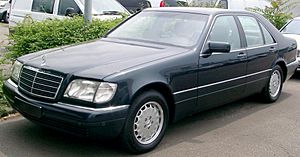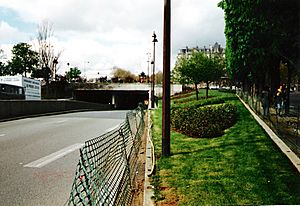Death of Diana, Princess of Wales facts for kids
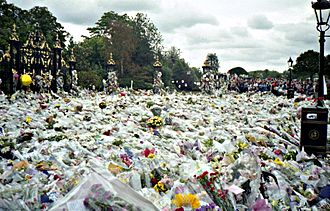
Flowers left outside Kensington Palace in tribute to Diana
|
|
| Date | 31 August 1997 |
|---|---|
| Location | Pont de l'Alma, Paris, France |
| Type | Car accident |
| Deaths |
|
| Non-fatal injuries | Trevor Rees-Jones |
| Inquiries | Operation Paget (2008) |
In the early hours of 31 August 1997, Diana, Princess of Wales, sadly died from injuries she got in a car crash. The accident happened in the Pont de l'Alma tunnel in Paris, France. Dodi Fayed, who was with Diana, and Henri Paul, their driver, also died in the crash. Diana's bodyguard, Trevor Rees-Jones, was seriously hurt but was the only person who survived.
Some news reports said that the crash happened because photographers, called paparazzi, were chasing the car. However, a French investigation in 1999 found that the driver, Henri Paul, lost control of the car while driving very fast. He was the deputy head of security at the Hôtel Ritz Paris. In 2008, a British investigation called Operation Paget also found that the crash was caused by dangerous driving from Paul and the paparazzi cars following them. Some reports said Rees-Jones survived because he wore a seatbelt, but other investigations showed that no one in the car was wearing one.
Diana was 36 years old when she died. Her death caused a huge wave of sadness and grief in the United Kingdom and around the world. Her funeral was shown on TV and about 2.5 billion people watched it. The Royal Family faced some criticism for how they reacted to Diana's death. People have remained very interested in Diana, and she is still often talked about in the news even decades later.
Contents
Circumstances of the Accident
Before the Crash Happened
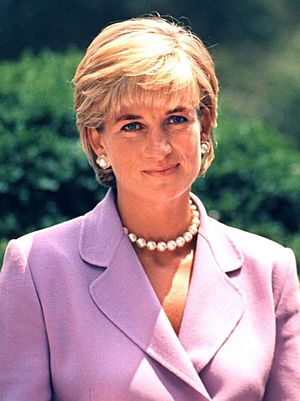
On Saturday, 30 August 1997, Princess Diana flew from Sardinia to Le Bourget Airport in Paris. She was with Egyptian film producer Dodi Fayed, who was the son of businessman Mohamed Al-Fayed. They were on their way to London after spending nine days on Mohamed's yacht. They planned to stay the night in Paris. Mohamed Al-Fayed owned the Hôtel Ritz Paris and had an apartment close by.
Henri Paul, who worked as a security boss at the Ritz, was told to drive a black 1994 armoured Mercedes-Benz S280 sedan. The plan was to avoid the photographers, known as paparazzi. A different car left the hotel first from the main entrance to trick the photographers. Diana and Fayed then left from a back entrance of the hotel around 12:20 AM on 31 August. They were heading to the apartment to get away from the many photographers waiting. Diana and Fayed were sitting in the back seats. Trevor Rees-Jones, a bodyguard for the Fayed family, was in the front passenger seat. No one in the car was wearing a seat belt. After leaving the hotel, they drove along the River Seine embankment road and entered the Pont de l'Alma underpass.
The Car Crash
At 12:23 AM, Henri Paul lost control of the car as it entered the Pont de l'Alma underpass. The car hit a white Fiat car, then swerved and crashed head-on into the thirteenth pillar that held up the tunnel roof. The car was going very fast, estimated at about 105 kilometers per hour (65 mph), which was more than twice the tunnel's speed limit of 50 km/h (30 mph). The car then spun around, hit the tunnel wall backwards, and stopped. The front part of the car was badly damaged. Witnesses who arrived soon after saw smoke. They also said that photographers on motorcycles "swarmed" the Mercedes before it went into the tunnel.
What Happened Afterwards
The photographers were driving slower and were a bit behind the Mercedes. When they reached the scene, some tried to help, opening doors and assisting the victims. Others took pictures. Police arrived about ten minutes after the crash, and an ambulance came five minutes later. Some witnesses were very upset and reportedly hit one photographer. Five photographers were arrested right away. Later, two more were held, and about 20 rolls of film were taken from them. Police also took their vehicles. Firefighters also came to help.
Rees-Jones had many serious injuries to his face and head, but he was still awake. The front airbags in the car worked. Diana was in the back right seat and was very badly hurt, but she was also still awake. The crash mainly affected the right side of her body. She was heard to say "Oh my God" many times. After police moved the photographers away, she said, "Leave me alone." A doctor who happened to be there first helped Diana. He said she had no visible injuries but was in shock. She was very upset and pulled out an IV drip, shouting. After being given medicine and taken out of the car at 1:00 AM, her heart stopped. But it started beating again after doctors performed CPR. Diana was moved to the ambulance at 1:18 AM, left the scene at 1:41 AM, and arrived at the Pitié-Salpêtrière Hospital at 2:06 AM.
Dodi Fayed, who was in the back left seat, was announced dead at the scene. Henri Paul was also announced dead at the scene after being removed from the car.
Diana's injuries were very severe. She died at the hospital at 3:00 AM. A doctor announced her death at a news conference at 6:00 AM.
Later that morning, French leaders visited the hospital. Around 5:00 PM, Diana's former husband, Charles, and her two older sisters arrived in Paris. They visited the hospital with the French president and thanked the doctors. Charles took Diana's body back to the UK later that day. Her coffin was covered with the royal standard flag. Her body was taken to a mortuary in London for an examination.
At first, news reports said Diana's car hit the pillar at 190 km/h (120 mph). It was later announced that the car's speed at the moment of impact was between 95 and 110 km/h (59-68 mph), which was about twice the speed limit of 50 km/h (30 mph). In 1999, a French investigation concluded that the Mercedes had touched a white Fiat Uno in the tunnel. The driver of the Fiat was never found for sure, though some believed it was a man named Le Van Thanh.
The British Foreign Secretary, Robin Cook, said that if the crash was partly caused by paparazzi chasing the car, it would be "doubly tragic." Diana's younger brother, the Earl Spencer, also blamed the news media for her death. An 18-month French investigation in 1999 concluded that the crash was caused by Paul, who lost control while driving too fast.
Public Mourning
People were invited to sign a book of condolence at St James's Palace in London. Another book was set up by the British embassy in the US. All 11,000 lights at the Harrods department store, owned by Mohamed Al-Fayed, were turned off until after the funeral. Throughout the night, volunteers helped people waiting in line along the Mall. More than one million bouquets of flowers were left at her London home, Kensington Palace. At her family's estate, Althorp, people were asked to stop bringing flowers because there were too many visitors and flowers on the roads, which became a safety risk.
By 10 September, the pile of flowers outside Kensington Gardens was 5 feet deep in some places. Fresh flowers, teddy bears, and bottles of champagne were later given to the sick, elderly, and children. Cards, personal messages, and poems were collected and given to Diana's family.
Funeral and Burial
Diana's death led to an incredible outpouring of public sadness. Her funeral at Westminster Abbey on 6 September brought an estimated 3 million mourners and onlookers to London. Outside the Abbey and in Hyde Park, crowds watched and listened to the service on large outdoor screens. Guests included US First Lady Hillary Clinton and French First Lady Bernadette Chirac, as well as famous people like singer Luciano Pavarotti and two of Diana's friends, George Michael and Elton John. Elton John performed a special version of his song "Candle in the Wind" dedicated to her, known as "Goodbye England's Rose." This song became the best-selling single ever in the UK and US.
During the funeral, the usual rules were set aside when guests applauded a speech by Earl Spencer. He strongly criticized the press and indirectly criticized the Royal Family for how they treated Diana. The funeral was watched by an estimated 31.5 million viewers in Britain. Around the world, it's thought about 2.5 billion people watched. The ceremony was shown in 200 countries and 44 languages.
After the ceremony, Diana's coffin was driven to Althorp in a Daimler hearse. Mourners threw flowers at the funeral procession for almost the entire journey. Cars even stopped on the opposite side of the M1 motorway as the procession passed.
In a private ceremony, Diana was buried on an island in the middle of a lake called The Oval at Althorp. Her coffin was very heavy because it was lined with lead, which is a tradition for British royalty. In her coffin, she wore a black dress and held a rosary. The rosary was a gift from Mother Teresa, who was a friend of Diana's and who had died the day before Diana's funeral. A visitors' center is open in summer months, with an exhibition about Diana and a walk around the lake. All profits from the center go to the Diana, Princess of Wales Memorial Fund.
Reactions to Diana's Death
The Royal Family's Response

Queen Elizabeth II expressed her sadness at Diana's death. Then-Prince Charles woke his sons, William and Harry, before dawn to tell them the news. When Diana's death was announced, the Royal Family's website temporarily changed to a black background with Diana's picture, name, and dates. An online book of condolence was also put on the website for people to write tributes. On the Sunday morning after Diana's death, the Queen, Prince Charles, Prince William, and Prince Harry all wore black to church services. The Royal Family later said that Charles, William, and Harry were "deeply touched" and "enormously grateful" for the public's support. Princes Andrew and Edward met mourners outside Kensington Palace. The Queen, Prince Philip, Charles, William, and Harry also viewed the flowers and messages left by the public.
Charles and his sons returned to London on Friday, 5 September. They made a surprise visit to see the flowers outside Kensington Palace. The Queen, who returned to London with Prince Philip, the Queen Mother, and Princess Margaret, agreed to speak to the nation on television. She viewed the flowers in front of Buckingham Palace and visited the Chapel Royal where Diana's body was resting. She also met crowds waiting to sign the books of condolence. Diana's brother, Earl Spencer, and her former sister-in-law, Sarah, Duchess of York, also visited.
The Queen and the Royal Family were criticized for following strict rules, and their efforts to protect Diana's grieving sons were sometimes seen as a lack of care. For example, Buckingham Palace at first did not fly the Union Flag at half-mast. Royal rules stated that the Royal Standard flag is only flown when the monarch is at the palace, and it never flies at half-mast because there is always a monarch. As a compromise, the Union Flag was flown at half-mast when the Queen left for Westminster Abbey on the day of the funeral. This set a new rule, and now Buckingham Palace flies the Union Flag when the monarch is not there.
Prince Harry said in 2017 that his mother's death caused him great sadness. William was 15 and Harry was 12 when Diana died. The boys received locks of their mother's hair from their aunt, Lady Sarah McCorquodale, after she returned from Paris.
Years later, William and Harry defended their father and grandmother's actions after their mother's death. Harry said: "[Our dad] was there for us — he was the one out of two left, and he tried to do his best and to make sure that we were protected and looked after." William stated: "At the time, my grandmother wanted to protect her two grandsons and my father as well. Our grandmother deliberately removed the newspapers and things like that so there was nothing in the house to read." Diana's sister, Lady Sarah McCorquodale, also supported the Queen's decision: "She did absolutely the right thing. If I'd been her, I'd have done that."
Politicians' Reactions
British Prime Minister Tony Blair said he was "utterly devastated" by Diana's death. US President Bill Clinton said he and his wife were "profoundly saddened." Kofi Annan, the United Nations Secretary-General, said her death "has robbed the world of a consistent and committed voice for the improvement of the lives of suffering children worldwide." German Chancellor Helmut Kohl said Diana had become a victim of "increasingly brutal and unscrupulous competition on the part of some of the media." In Australia, the Deputy Prime Minister, Tim Fischer, criticized the paparazzi for their intense coverage. Russian President Boris Yeltsin praised Diana's charity work. Other leaders who sent condolences included the Prime Ministers of Australia, Canada, New Zealand, and Israel, and the President of South Africa, Nelson Mandela.
After her death, people at an international meeting in Oslo to ban landmines paid tribute to Diana. She was a strong supporter of banning these dangerous devices. The Ottawa Treaty, which banned anti-personnel landmines, was adopted in Oslo in September 1997. Diana's work on landmines helped greatly in getting this treaty signed.
Public Reactions
In London, thousands of people brought flowers and stood outside Buckingham Palace after the news of her death. People started bringing flowers within an hour. The BBC flew its flags at half-mast. Both radio and television played the British national anthem, "God Save the Queen." Sporting events in the UK were changed.
People in the US were shocked. In San Francisco, about 14,000 people marched to honor Diana. In Los Angeles, more than 2,500 people turned a baseball field into a candle-lit memorial. In Paris, thousands visited the crash site and the hospital where Diana died, leaving flowers, candles, and messages. People also tried to visit the Hotel Ritz. On the day before the funeral, 300 British people in Paris held a memorial service. Landmine victims in Angola and Bosnia also honored Diana, saying her efforts helped raise awareness about landmines. In Egypt, Dodi Fayed's home country, people visited the British embassy to pay tribute. Many famous people, including actors and singers, blamed the paparazzi for their reckless behavior.
Mother Teresa, who had met Diana, expressed her sorrow. Prayers were held by Christian, Muslim, and Jewish communities. Mother Teresa died on 5 September 1997, the day before Diana's funeral.
Memorials to Diana
In the years after her death, many memorials were made to honor Diana. As a temporary memorial, people used the Flamme de la Liberté (Flame of Liberty) monument near the Pont de l'Alma tunnel in Paris. This monument was originally a gift from France to the US, like the Statue of Liberty. The messages of sadness have since been removed, and it's no longer officially a Diana memorial, but visitors still leave messages there. A permanent memorial, the Diana, Princess of Wales Memorial Fountain, was opened by the Queen in Hyde Park in London on 6 July 2004. A statue was also unveiled by her sons in the Sunken Garden of Kensington Palace on 1 July 2021.
Investigations and Theories
Nine photographers who had been following Diana and Dodi in 1997 were charged in France. France's highest court dropped these charges in 2002.
Three photographers who took pictures after the crash had their photos taken away. They were tried for invading privacy by taking pictures through the open car door. These photographers were found not guilty in 2003.
Even though the first French investigation said Diana died in an accident, some conspiracy theories have been suggested. Since 1998, Dodi Fayed's father, Mohamed Al-Fayed, claimed the crash was part of a conspiracy. He later said it was planned by a British intelligence agency on the orders of the Royal Family. His claims were dismissed by both the French investigation and Operation Paget. On 7 April 2008, a British investigation into the deaths of Diana and Fayed concluded that they were victims of an "unlawful killing" by Henri Paul and the drivers of the cars following them. Other factors included the driver's poor judgment and the fact that no one was wearing a seatbelt.
In 2013, Scotland Yard said they were looking into information from a source who claimed Diana was murdered by a member of the British military.
Diana in the Media
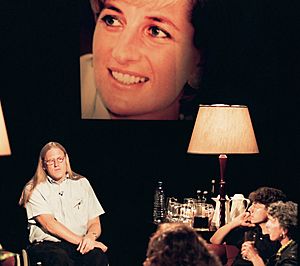
Diana was ranked third in a 2002 BBC poll called Great Britons, voted for by the public. She was behind Sir Winston Churchill and Isambard Kingdom Brunel. In the same year, another British poll named Diana's death as the most important event in the country's last 100 years.
Later in 2004, the CBS show 48 Hours showed photos from the crash scene. These photos were part of a French government report. They showed the back and middle of the Mercedes car still in one piece, including a picture of Diana without visible injuries, crouched on the back floor. People in the UK were upset by these pictures, feeling that Diana's privacy was being invaded. Buckingham Palace, Prime Minister Tony Blair, and Diana's brother criticized the show. CBS defended its decision, saying the pictures were shown to explain the medical treatment Diana received.
On 13 July 2006, an Italian magazine called Chi published photos of Diana in the car wreckage. This happened even though there was an unofficial agreement not to publish such photos. The editor of Chi said he published them because they hadn't been seen before, and he felt they were not disrespectful.
The British newspaper, the Daily Express, was criticized for continuing to write about Diana after her death. A 2006 report showed that the newspaper had many headlines about her, such as "Perhaps Diana should have worn seatbelt" and "Diana inquiry chief's laptop secrets stolen."
The events from Diana's death to her funeral were made into a 2006 film, The Queen, starring Helen Mirren as the Queen.
Internet Coverage
Diana's death happened when the Internet was becoming very popular. Many newspapers had already started online news services. BBC News had created online coverage for the 1997 general election. Because of the huge public and media attention around Diana's death, BBC News quickly made a website with news about her death and the events that followed. Diana's death helped BBC News realize how important online news was becoming, and a full online news service was launched later that year.
See also
 In Spanish: Muerte de Diana de Gales para niños
In Spanish: Muerte de Diana de Gales para niños
- Concert for Diana, a 2007 music concert to remember Diana


